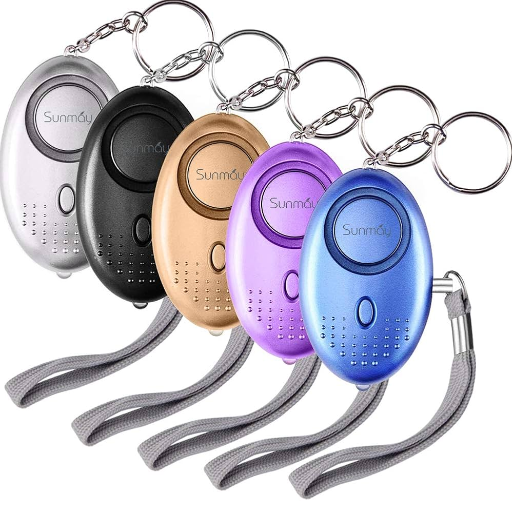Amidst a world that is becoming more and more unpredictable by the day, personal safety has emerged among individuals’ leading concerns. This manual intends to give its readers the necessary knowledge about self-defense proactively using personal keychain alarms. This article will discuss features, merits, and tips for choosing and using these small-sized protective gadgets. Whether it’s at night when you are walking alone during travel or even just staying at home feeling insecure, knowing how personal alarms can guarantee your security is essential. Let us, therefore, take a deep dive into different dimensions of individual protection that will enable us to always be in charge of our safety.
What is a Personal Keychain Alarm and How Does it Work?
personal keychain alarm
A personal keychain alarm is a small portable safety device that when activated will produce a loud noise, it does this to ward off possible danger and attract attention during emergencies. They are usually activated by pulling out a pin or pressing a button; their noise level ranges between 90-130 decibels which can startle attackers and notify people nearby. Most models are operated by batteries, with some having LED lights for more visibility, while others come with built-in whistles to produce a variety of sounds. Personal keychain alarms come in different designs and colors; hence, one can easily carry them on their keyring or bag or attach them to clothes, making it convenient for personal safety enhancement. Having an individual’s alarm gives one peace of mind because they know there is a way of calling for help if anything happens.
Understanding the Basics of a Personal Alarm
It is essential to know what makes personal keychain alarms practical and valuable. The main features that should be considered are:
- Volume: Personal alarms usually produce sounds between 90 and 130 decibels. This is a significant sound intensity because it has to be loud enough to attract attention and discourage attackers. More than 120 decibels can work very well, as it may cause disorientation or discomfort to an assailant.
- Battery Life and Power Supply Type: Most personal alarms use rechargeable or replaceable batteries. A long battery life is better for keeping the alarm operational at all times. Look for models that offer at least one year’s worth of battery life under normal use conditions.
- Method of Activation: Generally, alarms have a simple pull pin or button for activation. In case of emergencies, the activation method should be easy to understand and follow promptly. Also, some advanced versions allow smartphone connectivity for more functions like tracking and alerts.
- Other Features: Certain types of personal alarms have additional functions, such as LED flashlights that provide light during dark situations or integrated whistles that provide different sound options. These characteristics can improve safety overall.
- Size & Portability: Convenience is determined by how small the device is when not being used; hence, its importance lies in its size, too. Most personal keychain alarms are compact and designed to be lightweight so they can easily be attached to keychains or bags and accessed when required.
Knowing these factors will help potential users choose the right personal keychain alarm to suit their specific needs and situations best. While these devices provide extra security measures, please ensure you are also situationally aware and have other self-defense techniques in place.
How to Use a Keychain Alarm Effectively
To be practical with a keychain alarm, you must be able to activate and take care of it, while also knowing the best ways to use it in different situations. Here are some things you should know:
- Learn about the Alarm: Practice activating the alarm by pulling out its pin or pressing a button before an emergency occurs. Make sure you are comfortable using it when stressed.
- Place It Strategically: Attach this device to your keychain or bag so that you can quickly find it when necessary. Think of somewhere that is not likely to be hidden or buried among other objects.
- Do Regular Checks: Test if the battery works as required from time to time. Replace or recharge batteries once every six months, ideally, or according to manufacturer instructions.
- Use During Emergencies: When attacked or threatened, activate this gadget immediately to scare away offenders and call for help. Try pointing the sound towards potential helpers among onlookers.
- Combine With Other Safety Measures: A personal alarm should not be relied upon alone for self-defense but should be used in conjunction with staying conscious of one’s environment, avoiding dark spots, and having a plan B for personal security.
- Educate Yourself More: Enroll in martial arts classes that teach situational awareness skills. Knowing how your defense tools work in relation to each other or to other strategies greatly enhances safety levels.
By following these tips, your keychain alarm will become more than just another device in your pocket – it will be an essential part of your safety kit. Always remember that combining reactive measures with proactive ones makes any alarm system effective.
The Benefits of a Personal Safety Alarm
A self-defense alarm has many functions that are important for personal safety and peace of mind. Here are some notable advantages:
- Quick Attention: Whenever there is an emergency, it starts making a loud noise. Personal safety alarms usually emit sound between 120-140 decibels which can be heard from far away especially in crowded places.
- Prevention: Since the loud noise can scare attackers away or create awareness around it indicates help is coming so they should leave immediately.
- Portable: Most personal safety alarms are designed to be small and light so they can be easily attached to keychains, bags, or clothing and reached within seconds when needed most.
- User-Friendly: These devices are very easy to operate; you just activate them by pulling out a pin or pressing a button without any special skills required since they’re not complicated.
- Battery Life and Care: Alarms come with batteries that have long life spans ranging from several months to up to years, depending on how frequently one uses them; besides, there is also a low-battery indicator, which helps users maintain their gadgets properly.
- Signal For Aid: Apart from acting as self-protection tools, these gadgets can serve as distress signals seeking assistance hence may save lives in busy places where shouts may not be audible enough.
- Cheap Protection: They are relatively affordable, going for as low as $10 but not beyond $50. Hence, many people can afford them regardless of their financial status, thus ensuring personal security doesn’t drain someone’s wallet completely.
- Mental Reassurance: When individuals carry such items along with them wherever they go, this makes them feel safer about themselves, thereby giving them the courage to walk alone, even in strange territories.
- Application Flexibility: Although mainly meant for personal defense purposes during hiking trips, camping expeditions, etcetera, it still proves useful when faced with carjacking incidents, thereby widening its range of usefulness beyond protection against individuals only.
- Educative Consciousness: These devices can act as reminders, urging people to be more observant of what is happening around them while at the same time encouraging dialogue on safety tips among relatives and close pals.
By integrating personal safety alarms into our daily routines, we actively improve our protection levels and preparedness during crisis times.
Why Should You Consider a Personal Alarm with LED Light?
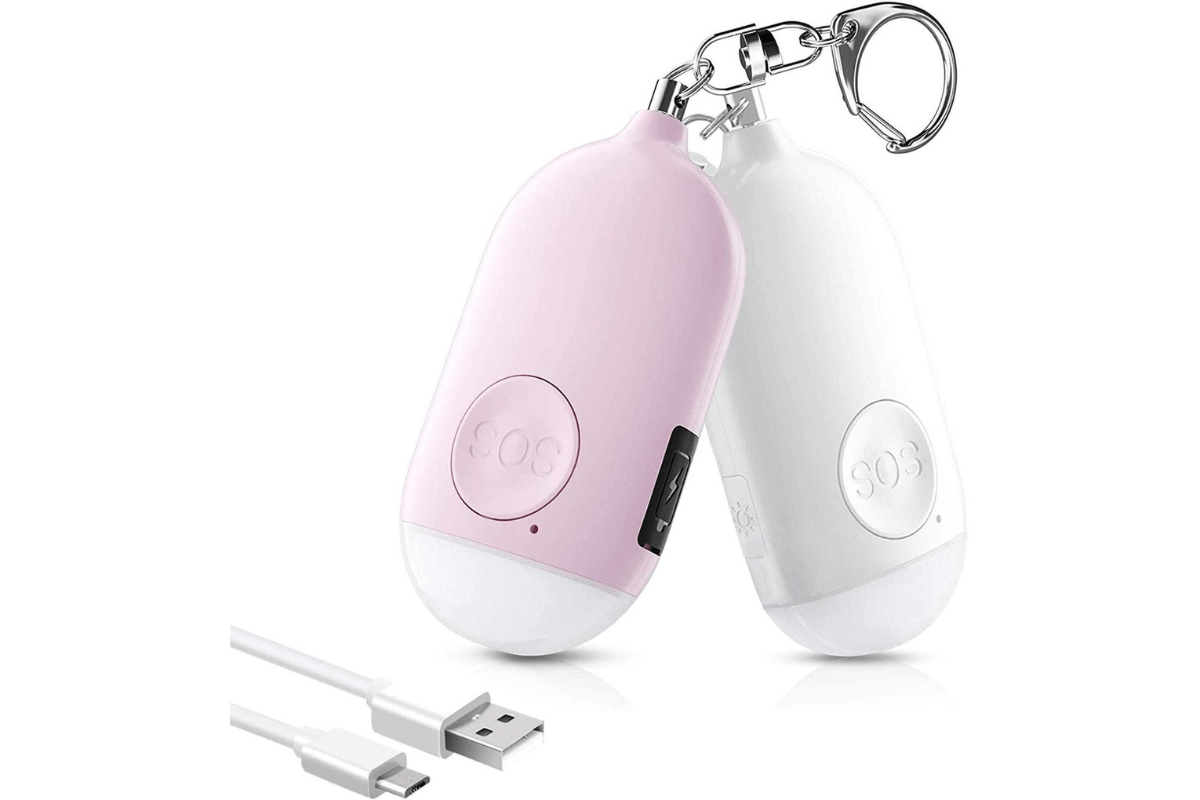
A personal alarm with a built-in LED light has many benefits, such as improving safety and usability. First, in dark places, the LED light can immediately illuminate the user’s surroundings, making it easy for them to move around, which might discourage assailants, too. Moreover, this light serves two purposes: it can act as a distress signal beacon and is also helpful when someone wants to find their keys or anything else in darkness. Another thing is that such alarms are usually small so they can be attached on keychains or bags conveniently remaining within reach at all times. The person’s safety during emergencies is greatly enhanced by a loud siren and bright lights since more people will be alerted around them. In general terms, getting yourself one of these personal alarms fitted with LEDs could add an extra level of preparedness across different scenarios.
Advantages of an Alarm with LED Light
- Better Visibility: Users can optimize their light by installing LEDs. This will help them travel when the sun is down or in poorly lit areas that may be hard to navigate.
- More effective deterrent: A bright LED coupled with a loud sound is a significant barrier because it is seen and heard. It is doubtful that attackers will approach those people who appear aware and armed with protective gadgets.
- Two-in-One Feature: Most personal alarms fitted with torches also have other functions, such as illuminating dark places during walks and serving as key finders.
- Portability: The small size of these alarms ensures that they can be easily carried around, attached to belts, handbags, or even tethered to key chains. This means that one will never lack access to them, thus enhancing convenience and preparedness.
- Ease of use: The majority of the alarms currently available are designed to be activated quickly so that users can deal with emergencies promptly.
- Very Loud Sound: Personal alarm systems usually produce sounds ranging from 90dBs up to 130 dBs, which should be enough noise level required for grabbing attention within proximity, especially if somebody finds themselves in some dangerous situation where they need help urgently.
- Long-lasting battery life: Some models have batteries that can last several months without replacement, while others may go for years. This depends on how often such devices are used, but most have sound backup systems that ensure reliability all day, even under heavy usage conditions.
- Weatherproofing features: Certain personal alarms equipped with lights have been made tough enough to withstand different weather elements making them perfect for outside usage regardless of what season it might be at any given time.
- Cheapness factor: People do not need much money when buying personal safety gadgets with LEDs since most of them cost very little. This makes these items affordable to everyone who cares about their well-being, whether young or old, and hence, they have become quite popular in recent times.
- Appearance attractiveness: Different designs and colors are utilized during production, so one can choose a personal alarm that matches their taste. This makes them want to carry it around constantly, so it becomes part and parcel of their daily routine activities.
Investing in an LED personal alarm is a great way to ensure personal security. This will help people stay safe while also giving them peace of mind in various situations. By looking at features like battery life and sound output, among other technical specifications, people can select the best alarms suitable for them depending on what they want to use them for.
How an LED Light Enhances Personal Safety
One’s safety is raised significantly by an LED light as it offers visibility and vigilance in places with poor lighting. The following are the main points on how safety can be improved with LED lights, including also their technical parameters:
- Better Visibility: This type of light produces strong beams that can effectively illuminate darkness, enabling people to move around safely. Expected brightness levels for individual alarms range from 100 to 300 lumens.
- Catching Attention: LED lights have bright flashes that can attract the attention of anyone passing by, thereby increasing the chances of getting help during emergencies. Many models have strobe functions that make them even more visible.
- Small Size and Portability: These lights are light in weight and easy to carry around so that one has them at hand whenever needed. They normally measure between two inches and six inches, hence fitting well into pockets or bags.
- Long Life Span: LEDs last longer than traditional bulbs because they can last up to fifty thousand hours before dying out, thus reducing the frequency of replacements or maintenance.
- Energy Saving: LEDs consume less power than incandescent lamps, so they work longer on smaller batteries. The average power consumption is about 0.5-2 watts, which greatly improves battery life.
- Robustness: Several LED lights are made with solid materials that can withstand harsh weather conditions making them suitable for outdoor use under different situations. Additionally, shock or vibration do not spoil such lamps easily; hence, they are more dependable.
- Various Uses: Some personal alarms combine LEDs with other features like sirens or whistles, providing many safety options within a single device. This versatility makes these gadgets applicable in various scenarios.
To conclude, if you want maximum security, then include an LED light in your personal alarm because apart from being energy efficient, it also enhances visibility and attention-attracting abilities, thereby serving as an invaluable tool for personal protection across different settings.
Top Features to Look for in an LED Personal Alarm
When choosing an LED personal alarm, several factors should be considered to ensure it works as well as possible and keeps you safe too:
- Volume: Look for ones that produce 120 decibels or more because this range is usually loud enough to attract attention from far away and discourage potential attackers.
- Battery: If rechargeable batteries are used instead of disposable ones, they will save money and help protect the environment; USB chargers can also be convenient.
- Strobe Light: Some models have flashing strobe lights built into them, which can flash at different speeds. These make people more visible but might also temporarily blind someone who wants to hurt you, giving you a chance to run away.
- Waterproof Rating: An IP (Ingress Protection) rating indicates how well an item can resist dust particles (first digit) and water droplets such as rain or sweat (second digit); therefore, any sound LED personal alarm should have at least IPX4 protection, i.e., splash-proofing or better.
- Size & Weight: A compact lightweight design weighing under 5 ounces ensures portability without discomfort even if carried all day long.
- Durability: Ensure drop-proof construction using materials like hard-wearing ABS plastic or aluminum alloy shells; outdoor enthusiasts may prefer ruggedized models with additional impact resistance features for extended use outside during activities such as hiking, camping, etc., where accidents could quickly happen.
- Ease Of Use: Simple activation methods should be incorporated, like pull pins, push buttons or switches so that anyone can figure out how to operate them quickly under stress regardless of whether they are familiar with the particular brand/model being used at the time;
- Multiple Functions: Additional useful features may include a built-in LED flashlight(s), whistle(s) for attracting attention when within earshot of others who might help, smartphone apps that can link various personal safety devices together wirelessly via Bluetooth LE (Low Energy) technology, thereby creating a virtual network of guardians around the user in case something goes wrong, etc.
- Visibility: Choose bright LED lights visible from all angles, such as those emitting red or white beams, since these colors are known to be highly conspicuous especially during daylight hours but even at night too if directed towards oncoming traffic or potential rescuers;
- Reviews & Ratings: Always read what others have said about any given product before buying; this way, you will get an idea about how well it is likely to perform in real-world situations, as opposed to just relying on manufacturer claims alone, which may not always live up to expectations when put under scrutiny by customers who know best, having used them themselves already.
Keeping these points in mind should enable anybody looking for an LED personal alarm that reliably serves its purpose across different scenarios.
How Loud is a 130db Personal Alarm?
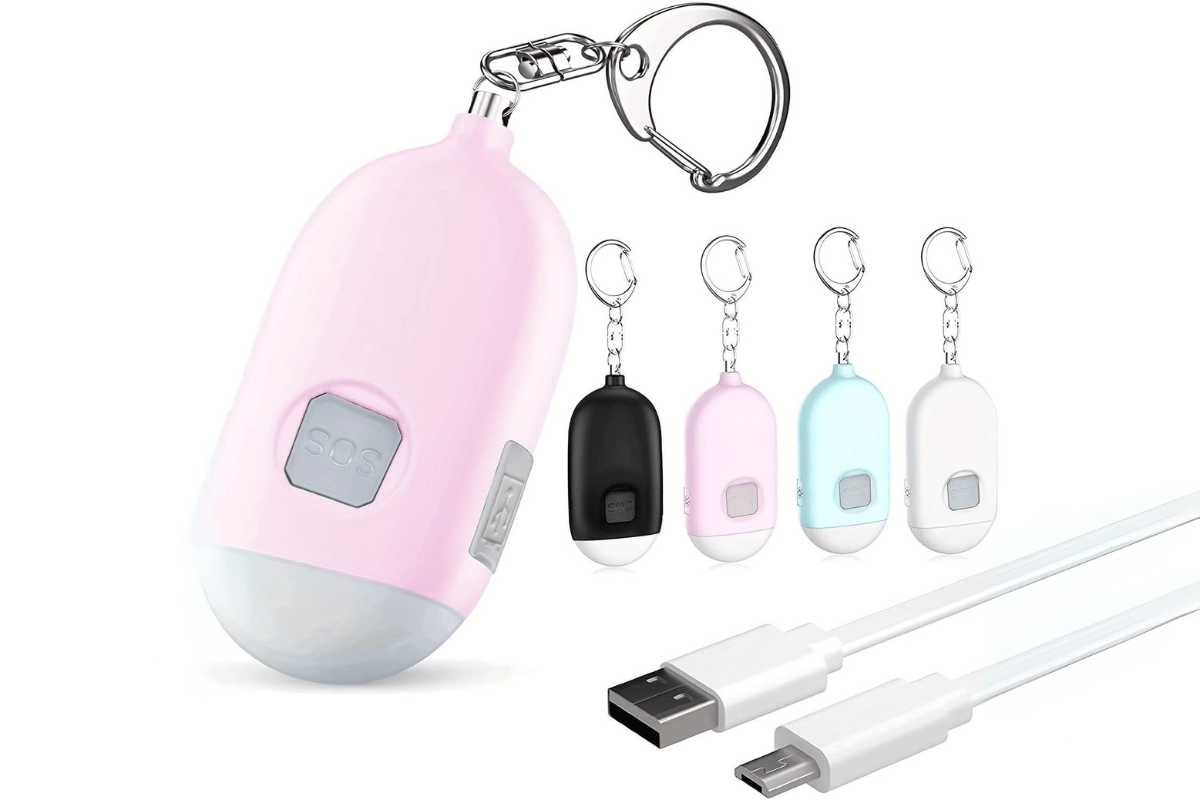
A personal alarm that has 130 decibels is deafening. It may be compared with the noise at a rock concert or when a plane takes off 200 feet from someone. This number of high decibels was established to startle people and get them noticed during emergencies because it is so piercing. The reason why such intensity helps prevent possible dangers lies in its audibility over long distances, which can attract witnesses who will likely come for help more likely than not. Users’ safety awareness increases manifold because they can produce loud sounds and be portable around any situation or environment they find themselves in.
Understanding the Decibel Level
When it comes to discussing sound levels, a person should know the decibel (dB) scale. This is because the decibel scale is logarithmic and represents a tenfold increase in intensity for every 10 dB. For instance, if you measure one sound at 70 dB and another at 60 dB, then the former will be ten times louder than the latter. Below are some critical technical parameters of personal alarms’ sound levels:
- Threshold of Hearing: 0 dB – It refers to the minimum level of sound that an average human ear can hear.
- Whisper: Approximately 20-30 dB – At this level, people may not hear each other speaking even in quiet surroundings due to its deficient volume.
- Normal Conversation: About 60 dB – The sound produced during an average conversation falls into this range.
- Busy Traffic: Approximately 85 dB—When exposure exceeds a certain duration or frequency, this amount may harm hearing ability.
- Threshold of Pain: Around 120-130 dB – These sounds can make ears hurt; they also have the potential to damage them permanently as well.
- Jet Engine at Takeoff: Around 130-140 dB – A jet engine taking off creates noise equivalent to that generated by personal alarms with ratings of up to about one hundred thirty decibels.
- Rock Concert: Often exceeds 110 dB. Such loudness levels may result in immediate discomfort and lead to long-term negative impacts on hearing capacity.
Knowledge about these measurements enables individuals to appreciate the effectiveness (in terms of audibility and attention-seeking abilities) of maximum attention-seeking ability emergency-designed alarms with output levels rated at one hundred thirty decibels.
The Effectiveness of a 130db Alarm in Self-Defense
A personal alarm with 130dB of sound power can be an extremely useful gadget for self-defense and personal protection. First, it can be heard from a long distance away, scaring away attackers but also bringing attention to the situation from people nearby or law enforcement officers. Second, being much higher than ordinary conversation voices or quiet alarms, the piercing volume exceeds common noise thresholds, too.
Here are some main reasons supported by technical parameters and data collected by multiple reputable sites:
- Maximum Audibility: The loudness is at 130dB, equivalent to the noise produced during take-off by a jet engine. This means that it would still work even on crowded streets with many other sounds around.
- Attention-grabbing: These types of personal alarms are made uncomfortable on purpose so they can attract immediate response from anyone who hears them—whether they were intended for such a person or not. The reflexes should be activated in both parties involved—targeted individual(s), general public passing by, etc.; thus, chances of getting timely assistance during crisis moments increase.
- Safety Enhancement: According to studies, when people know that they have something like a very noisy personal alarm with them, especially when walking through risky areas alone at night, their confidence levels rise significantly. They become more aware of their surroundings while also being able to react quickly if the need arises, hence making it possible for them to stay safe even in potentially dangerous environments.
- Legal Implications: The loud, disruptive nature exhibited by 130 decibel alarms falls within legal boundaries regarding use against harassment or assault cases, thereby affecting potential offenders’ conduct patterns.
Therefore, using a 130db alarm helps protect one’s life and provides another avenue for victims to call for help in distress situations.
Comparing Different Decibel Levels in Alarms
When assessing personal alarms, knowing the difference in decibel (dB) levels is crucial as this will help establish their effectiveness during emergencies. The following are key points to note based on findings from credible sources:
1. Below 90 dB:
- Sound Level: It can be compared with normal conversation (60 dB).
- Effectiveness: These alarms are generally considered weak when attracting attention in places with high background noise.
- Justification: Such an alarm may not be heard because of other sounds and, therefore, not helpful during emergencies.
2. 90-100 dB:
- Sound Level: Sounds like a lawnmower (90-95 dB).
- Effectiveness: It may get noticed but not loud enough for immediate action.
- Justification: Although such an alarm is audible, it could still go unheard due to city sounds, which would reduce its reliability in critical events.
3. 100-120 dB:
- Sound Level: Similar to thunder or chainsaw (110 dB).
- Effectiveness: Can attract more attention though response may vary with distance from source.
- Justification: Even if people find this level alarming, they may take some time before reacting because they first have to identify where the sound is coming from.
4. 120-130 dB:
- Sound Level: It’s like being at a rock concert next to speakers or standing near a jet engine during takeoff (125 dB).
- Effectiveness: Very good at drawing attention; leads to immediate involuntary reflexes.
- Justification: A person cannot ignore loud noise of such magnitude, so it is suitable for creating personal safety awareness among individuals within the earshot range of devices emitting sound waves at an intensity corresponding to this category.
5. Above 130 dB:
- Sound Level: Nearly reaches a painful threshold (130-140 dB).
- Effectiveness: Works exceptionally well as both deterrents and calls for assistance signals.
- Justification: These types of alarms do not only wake up potential witnesses but also make criminals pause their activities due to disruptive nature caused by strong vibrations produced when sound wave energy hits solid materials within vicinity such as walls or floors.
To put it briefly, personal alarms need to be designed to operate at levels above 120 dB to ensure their maximum effectiveness during emergencies. This will greatly heighten individual safety through the audibility of prevention and quick response signals.
How to Choose the Best Personal Safety Alarm for Women
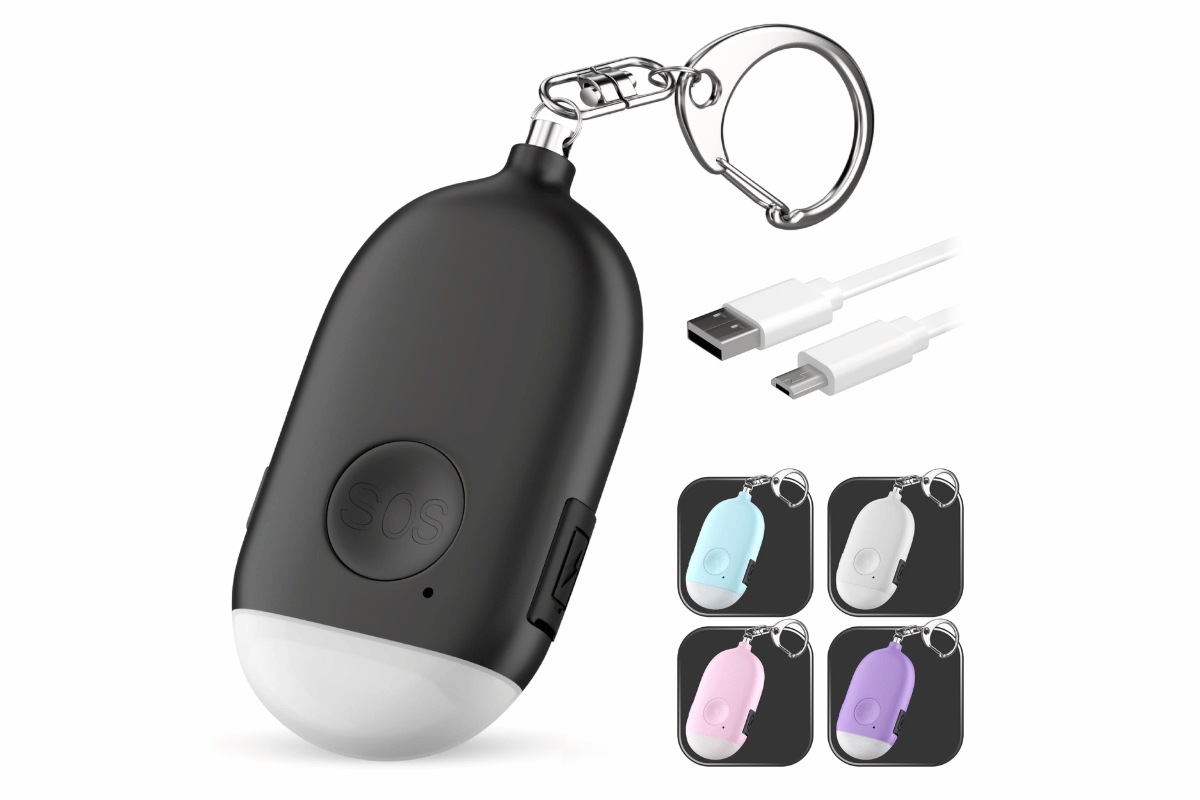
To guarantee efficiency and convenience, there are several things that you should take into account when selecting the best personal safety alarm for women. First and foremost, it must be loud enough to attract attention during emergencies; 130dB or higher is advised as the decibel level. The other thing is size and portability because small-sized ones, which are also lightweight, can easily fit in a purse or hang on a keychain. After that, think about additional features such as an LED light that enhances visibility at night or maybe having a built-in whistle for more deterrence power. Usability can be improved if it is durable and water-resistant, enabling different uses within different surroundings. Lastly, go through customer reviews as well as ratings to get what users have experienced concerning its reliability, thus ensuring that not only does the chosen alarm meet your needs but also comes from a reputable brand.
Essential Features for Women’s Alarms
When identifying personal safety alarms for women, a few key features have been identified through evaluations on top-rated safety websites:
- Volume: The alarm should be loud enough to scare away attackers and attract immediate attention. Many experts suggest that it should have at least 130 decibels.
- Portability: Light-weight and compact size are essential characteristics of any portable alarm system that can fit into your pocket or handbag without adding much weight or bulkiness. Some models weigh as little as 3 ounces, making them suitable for everyday carry (EDC).
- Multi-functionality: Some devices have additional features other than sounding off an alarm, such as strobe lights, which help increase visibility, especially during dark hours when most attacks occur. A whistle is another option most people prefer because it provides multiple ways of signaling for help.
- Durability: A good self-defense device should be sturdy enough to withstand impact in case you accidentally drop it while running away from danger or during a physical struggle with an assailant. The gadget’s waterproofing feature can also come in handy if you intend to use it outdoors frequently.
- Battery Life: Nobody wants to find themselves defenseless when faced with an imminent threat because their safety gadget runs out of power unexpectedly. Therefore, always go for those equipped with long-lasting rechargeable lithium-ion batteries; alternatively, ensure its shelf life is above six months before replacement becomes necessary.
- Ease of Activation: The ease at which you can switch on/off these gadgets determines whether they’ll serve their intended purpose effectively, so choose something user-friendly like push button systems instead of complex ones involving hidden switches lest they activate by mistake and then draining all energy reserves rendering useless when needed most.
- Design: A suitable personal security apparatus must be easy to carry unnoticed; hence its shape and overall appearance should resemble everyday items such as key fobs or wearable accessories.
- User Reviews: Always read what other customers say about any specific brand/model under consideration. This will help gauge reliability based on past experiences encountered by different users who have already tested them in real-life situations. Positive feedback from satisfied customers gives one confidence that the product is worth trying out.
By matching these features with technical specifications, buyers can find personal safety alarms that not only meet their requirements but also heighten their general feelings of safety.
Top Personal Alarms for Women’s Safety
To choose a personal alarm, consider different models that have been highly rated as effective and dependable. These are the top 10 personal alarms currently recommended by many reputable sources:
1. Sabre Personal Alarm
- dB: 120db
- Features: Small, lightweight, can be attached to keychains, and has LED lights built into it.
- Justification: It is loud enough at a high decibel level that it can be heard over long distances, making this device helpful in attracting attention whenever necessary.
2. Vigilant Personal Alarm
- dB: 130db
- Features: A rechargeable battery pack with strobe lights is included, and wrist straps are also provided.
- Justification: Extremely loudly sounding sirens partnered with visibility-improving attributes like strobe lights will increase safety during emergencies.
3. KABOER Personal Alarm
- dB: 140db
- Features: Portable design; comes equipped with rechargeable batteries and a clip-on option for easy attachment.
- Justification: The loud alarm can effectively scare away potential threats, while its portability ensures you always have it around when required.
4. Cooyoo Personal Alarm Keychain
- dB :130db
- Features: Activated by pulling out the activation tab, sleek design in a lightweight package
- Justification(s): Its simplicity of use, achieved by pulling the actuation tab and its elegant finish that does not attract much attention, makes this device suitable for daily wear, such as shopping or walking alone in guarded places after dark.
5. Mace Brand Personal Alarm
- dB:130db
- Features: Whistle included; one-button operation; rechargeable battery built right in.
- Justification(s): The extra whistle provision allows alternative signaling methods depending on the situation, plus additional features like single-button activation. It also has built-in batteries that can be recharged quickly, so there is no need to keep buying new ones all the time.
6. AOTeng Personal Alarm
- dB :150db
- Features: Flashlight function; rechargeable; available in different colors.
- Justification(s): The loudness of the alarm and the flashlight feature makes it very good for outdoor activities such as camping, where emergencies may arise during night hours, or while hiking through dense forests without any other source of light nearby.
7. Runteng Personal Alarm
- dB:130db
- Features: Built-in LED light; sleek design with different color options.
- Justification(s): Bright light-emitting diodes complementing loud sounds produced by alarms serve to improve visibility when incidents occur at dark places like parking lots late at night or even inside houses during power blackouts caused by natural disasters like hurricanes hitting coastal regions .
8. SoulBay Personal Alarm Keychain
- dB:140db
- Features: Lightweight; continuous strobe feature included; rechargeable battery built-in.
- Justification(s): Continuous flashing lights coupled with persistently sounding sirens maximize the chances of seeing and hearing what is happening around you, thus increasing personal safety in critical situations.
9. KARWEN Personal Safety Alarm
- dB:120db
- Features: Small size, easy to operate with a keychain loop attachment.
- Justification: It’s simple enough to use every day but still has some power in case protection is needed most.
10. Bell&Howell Personal Alarm
- dB: 140db
- Features: Panic button, built-in light that any user can easily operate.
- Justification: Additional panic buttons provide immediate assistance when faced with threatening situations.
By examining the features and technical specifications of these devices, users will be able to identify one that best suits their requirements while ensuring that it is reliable and effective.
Why Personal Alarms are Essential for Women’s Security
Personal alarms play an important role in women’s safety in many places. They are designed to be easy to reach and operate so that women can quickly call for help if they need to. The high decibel levels—usually between 120 dB and 140 dB—work as a strong deterrent against potential attackers, attracting immediate attention to a situation and potentially scaring off aggressors.
- Promptness of response: Personal alarms emit very loud sounds, sometimes up to 140dB; this is enough to alert persons within the vicinity and elicit speedy assistance.
- Ease of use: Most models have easily activated features, such as panic buttons or keychain loops, which enable quick usage without fumbling around looking for them.
- Portability: Personal alarms are small enough to fit into purses or can be attached to key rings, making them handy whenever necessary.
- Visual deterrence: Some models have built-in LED lights that increase visibility during emergencies, enabling others to see where the user is located more easily.
- Versatility: Designed for late-night outings and outdoor adventures, among other situations, personal alarms give confidence by ensuring protection in diverse environments, thus allowing women to move about freely.
Incorporating these features not only provides immediate safety options but also acts as a preventative approach to individual defense, thereby positioning it as an indispensable device for females in today’s world.
Can a Personal Alarm Be Used in Conjunction with Other Self-Defense Tools?
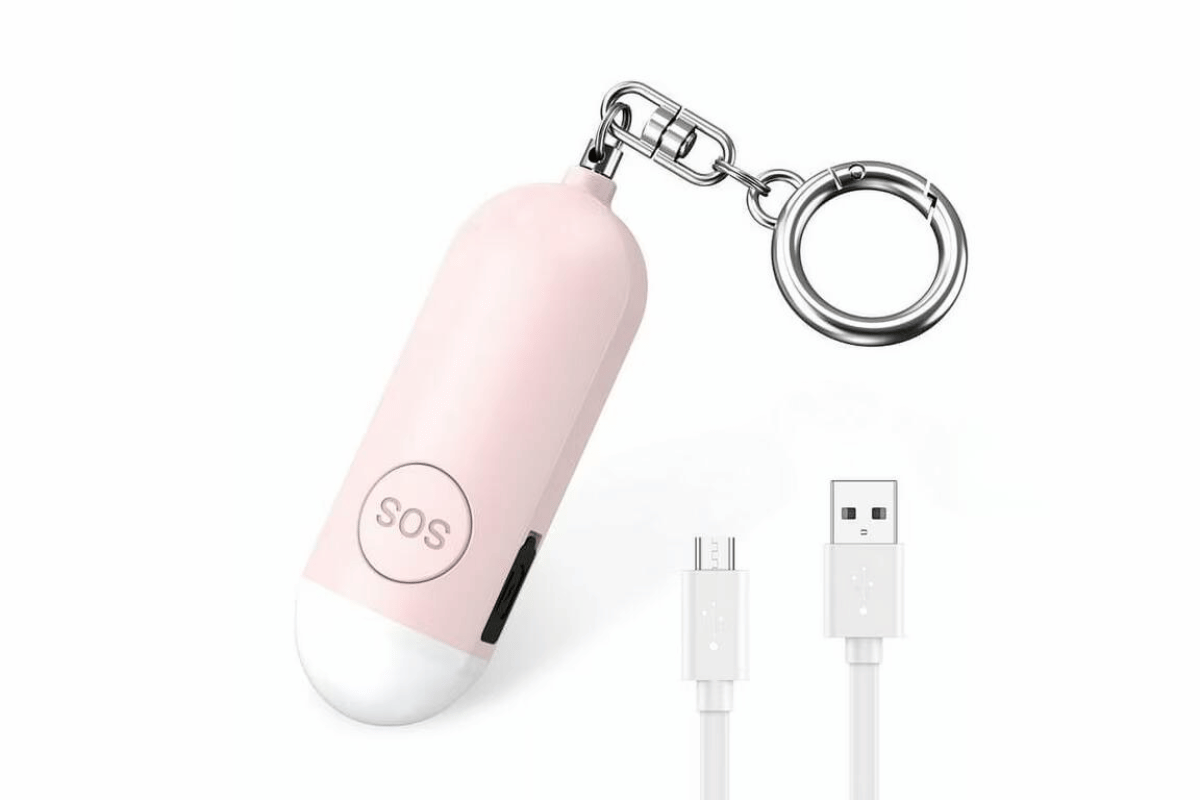
Indeed, using a personal alarm in addition to other self-defense devices is an excellent way to stay safe. For instance, some experts advise people to carry pepper sprays or tactical flashlights alongside personal alarms. In cases where one needs protection or wants to scare off possible attackers, the alarms act as distractions while the other tools work as deterrents. Moreover, suppose you wish for more security in different circumstances. In that case, it may help to pair a personal alarm with self-defense keychains or stun guns, which create various layers of defense around oneself. It is about feeling confident and protecting yourself from potential threats by using many techniques simultaneously, thus increasing the chances of scaring away an assailant and receiving timely aid at once.
Combining Personal Alarms with Pepper Spray
Pairing personal alarms with pepper spray is a tactical method of self-defense. They create noise and can disorient an attacker, in addition to letting people know that there is potential danger around them. This works better when combined with pepper sprays because it gives the user an opportunity to disable the assailant while attracting help at once.
Below are some technical considerations in blending these two self-defense tools:
- Personal Alarm Decibel Level: Personal alarms produce sounds between 100 and 130 decibels. The noisier the alarm, the better, as this makes it easily noticeable during emergencies.
- Pepper Spray Effective Range: The average reach for standard pepper sprays is 8 to 12 feet. It must be within this distance to put down your opponent effectively.
- Period of Time-Taking Spraying: Most brands offer continuous spray lasting between 5 –15 seconds, giving enough space to separate oneself from threats.
- Ease of Use: A pull pin or button usually activates personal alarms; on the other hand, all that is required for operation under stress should be a simple press mechanism by pepper sprays. Both must be readily available and operable during stressful moments.
- Size and Portability: Both ought to be small and lightweight for easy carriage; keychains are commonly used to hang personal alarms, while pockets or purses can accommodate pepper spray cans.
By considering these aspects and merging personal alarms with pepper sprays, individuals will have fortified their ways of defending themselves, thereby remaining confident in any given scenario where safety becomes a concern.
Using a Personal Alarm Alongside Other Self-Defense Keychain Tools
Several factors must be taken into account to ensure that a personal alarm is integrated with other self-defense keychain tools effectively and is always ready for use. Here are some of the main considerations from an analysis of best online self-defense resources:
- Volume: Personal alarms’ loudness ranges exceptionally; certain types can produce between 120 dBs to even 140 decibels. This strength is vital because it can catch somebody’s attention from far away, which might discourage an assailant.
- Method of activation: When under pressure, ease of operation becomes critical. Pull cords or push buttons that are quick to respond may be found on many personal alarms, while different self-defense items such as pepper sprays and keychain knives require simple methods of activating them, too, so that they do not fail due to hesitation.
- Alert visibility: In dark areas where light is scarce, adding a powerful LED lamp to a portable alarm would increase its chances of being seen by others. This two-in-one feature can help one get noticed but also illuminate his/her surroundings for safety purposes.
- Portability: If you want something easily accessible for your personal security needs, consider size. Lightweight mini alarms, alongside other complementary self-protection devices (like tiny pepper spray containers), ought to be designed small enough that they can be added to key rings or bags, enabling individuals to carry them wherever they go daily without feeling inconvenienced.
- Psychological factors—The potential impact deterrence Having multiple ways to defend oneself psychologically plays a vital role in preventing threats. A person who knows he has non-lethal weapons like mace coupled with personal alarms may have confidence that scares off criminals before such situations escalate into dangerous levels.
Understanding these parameters will enable intelligent pairing of personal alarms with other defensive keychain tools, thereby creating more comprehensive plans for dealing with unanticipated events while increasing our preparedness against them.
Maximizing Personal Safety with Multiple Devices
To maximize personal safety using several devices, insights from leading safety websites must be considered. These are the key recommendations of the best sources:
- Tools for Layered Self-Defense: Carrying a combination of personal alarms, pepper spray, and tactical pens can provide flexible options for self-defense and situation awareness. Each tool should have a different purpose; alarm systems are used for alerting others, pepper sprays are meant for instant protection, and tactical pens serve both self-defense and utility functions.
- Convenience: All devices should be easily accessible. They should be stored in specific pockets or compartments of bags that can be reached within the shortest time possible when one is under pressure. The activation mechanisms, such as pull cords, must be easy to use even in high-stress situations.
- Community Involvement Features: Some personal alarms have been designed with modern features that allow users to send smartphone notifications to friends or people around them in general. Ensuring that these features work well and testing them enhances an individual’s safety net.
- Battery Life Span and Maintenance Practices: Check all your devices regularly to confirm if they are still operational whenever necessary. This includes replacing batteries in personal alarms and testing canister pressure on pepper spray units, among other things.
- Training and Familiarization: Know how each device is used and its effectiveness. Muscle memory can be reinforced through daily practices with personal alarms and other self-defense equipment, thus enabling quick response.
- Physical Exercises: Personal security gadgets may go hand-in-hand with martial arts training sessions aimed at enhancing physical fitness levels necessary for self-defense purposes. Quite often, people learn skills for how best to use these tools together with their bodies during dangerous encounters, thereby heightening individual safety standards.
- Legality Aspect: Be conversant with laws governing the possession or usage of various weapons like knives; this will prevent any legal tussles arising from carrying them around when emotionally charged up due to fear. Always confirm compliance during such moments.
Individually, these safety measures may appear insignificant, but when combined strategically, they create a holistic approach to self-defense that not only improves personal security but also boosts confidence in dealing with threats.
Frequently Asked Questions (FAQs)
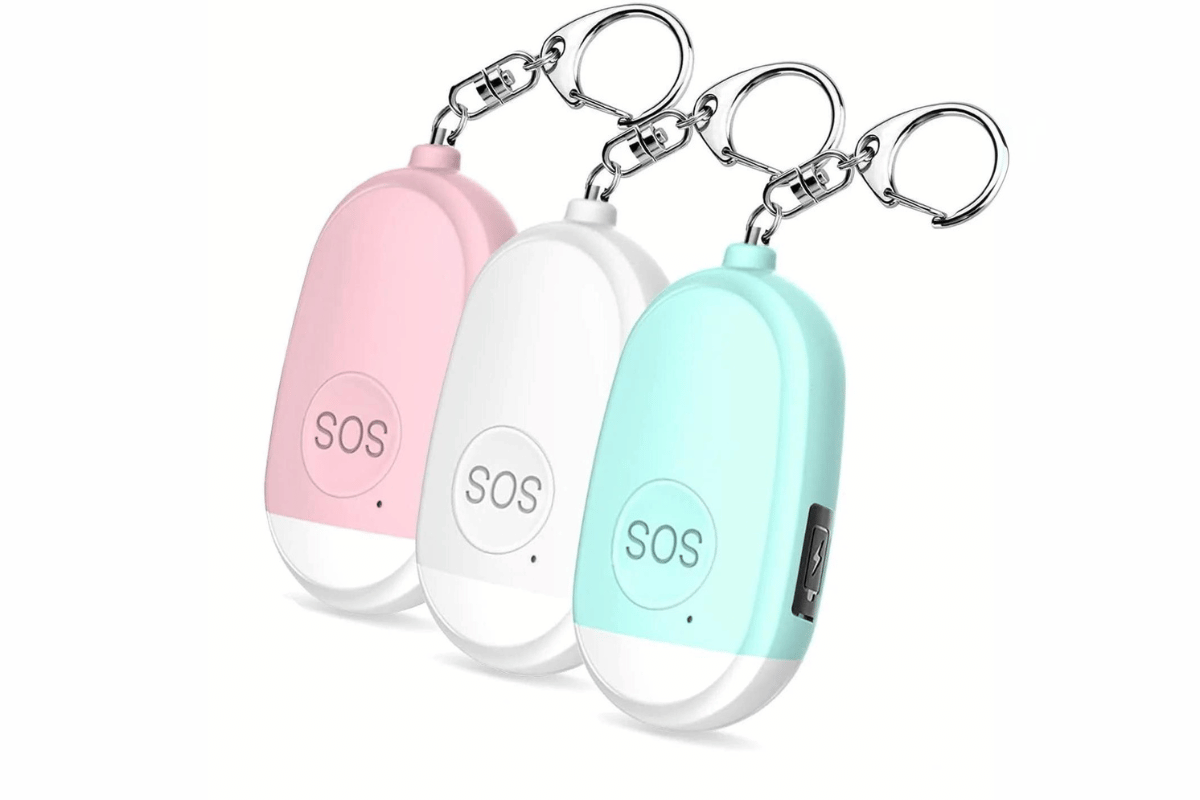
1. What is a personal safety device?
A personal safety device enhances an individual’s security and provides protection in various situations. This includes items like personal alarms, pepper spray, and self-defense keychains.
2. Are personal alarms effective?
Yes, personal alarms can effectively deter potential threats by emitting a loud sound that attracts attention. They can also provide the user with a sense of empowerment and safety in various environments.
3. Can I carry pepper spray anywhere?
No, the legality of carrying pepper spray varies by state and locality. It is crucial to check your region’s regulations to ensure compliance before carrying or using pepper spray.
4. How do I maintain my safety devices?
Maintaining safety devices involves regularly checking their functionality, replacing alarm batteries, and ensuring that self-defense sprays are within their expiration dates and properly pressurized.
5. Is training necessary for using self-defense tools?
While it’s not mandatory, training is highly recommended. Familiarizing yourself with self-defense tools significantly increases their effectiveness when needed and can build your confidence in using them.



